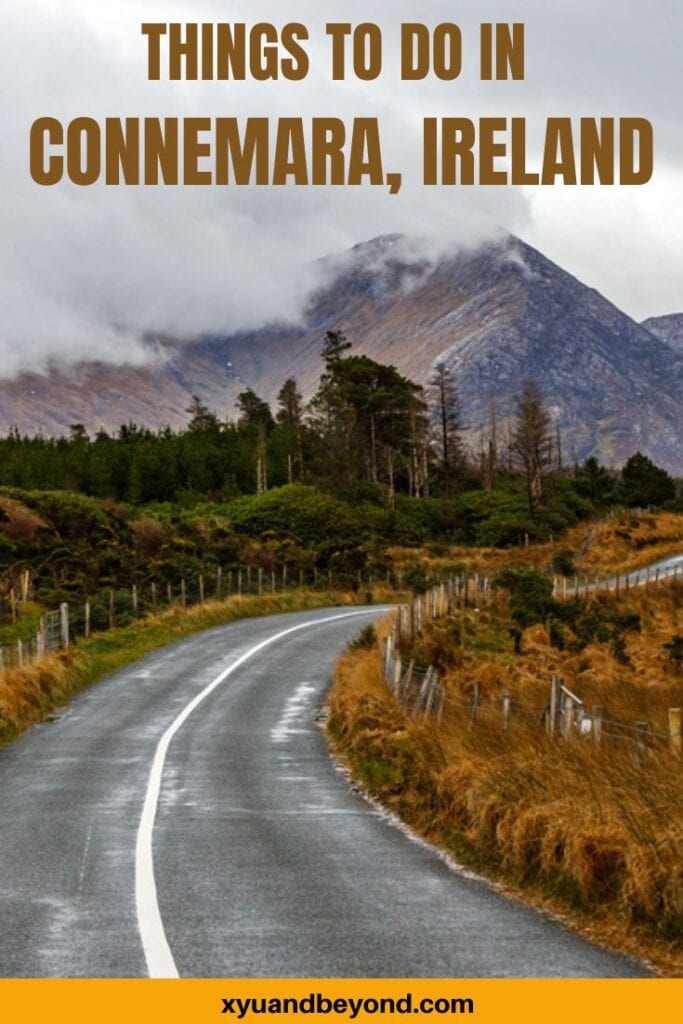28 Best Things To Do In Connemara, Ireland
A wild expanse of land on Ireland’s Wild Atlantic Way Connemara has inspired poets from Seamus Heaney to Yeats. Oscar Wilde described Connemara as a “wild mountainous country, in every way magnificent”.
Connemara is a region of County Galway an area of peat bogs, worn-down mountains, glistening loughs, pristine beaches and stunning primal landscapes. There are many things to do in Connemara co Galway and if you want to escape cities and truly experience Ireland you must visit this glorious area.
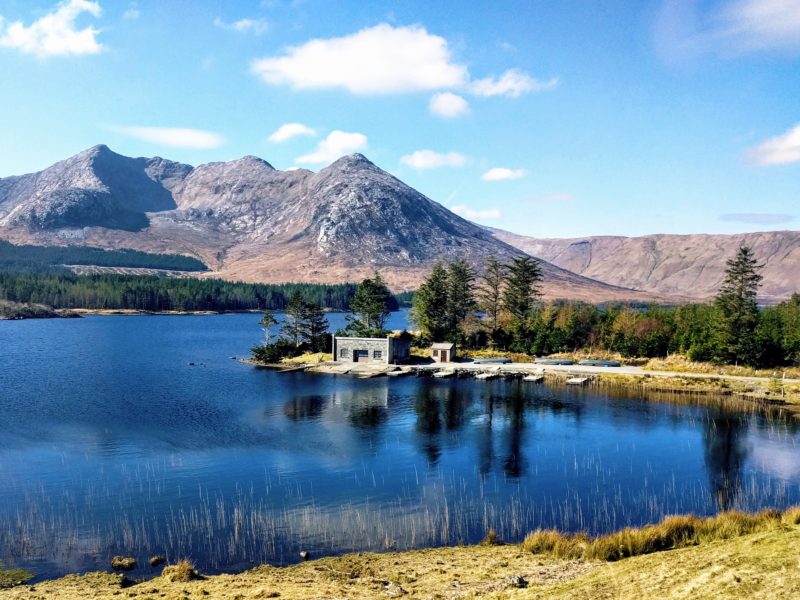
The boundaries of Connemara are somewhat nebulous one common definition is that the area of Connemara consists of most of west Galway including part of the county west of Lough Corrib and Galway city, contained by Killary Harbour, Galway Bay and the Atlantic Ocean. Another definition is that it is the historical territory of Conmhaicne Mara who were the earliest settlers in the area and gave their name to Connemara. This territory borders County Mayo.

Xyuandbeyond is reader-supported. When you buy through links on our site, we may earn an affiliate commission. You can read my privacy policy here.
When to Visit Connemara
Connemara is stunning in the summer months you won’t get long days of hot sun but in July and August temperatures will be around 19 degrees and it might be somewhat drier than the rest of the year. This is also the perfect time of year to go wild camping or even Glamping.
Spring and fall in Connemara are quite glorious with the trees beginning to turn colour in the fall and the wild gorse glowing yellow everywhere.
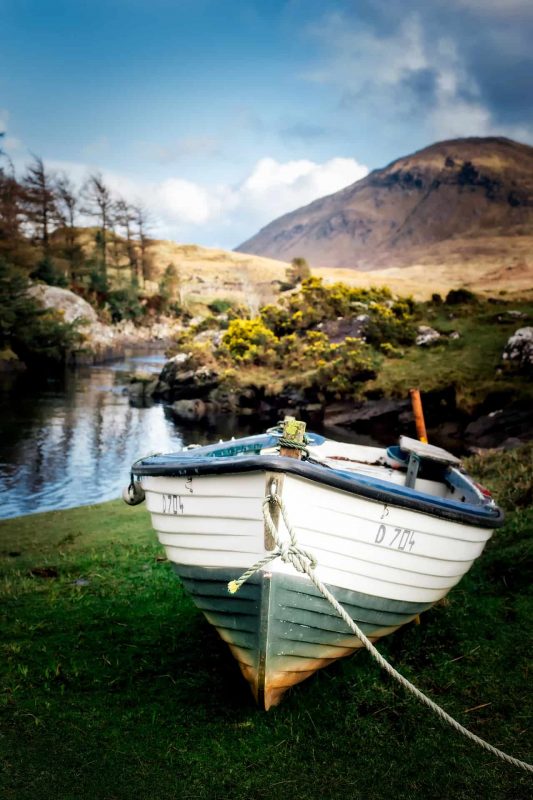
How to Get Around Connemara
Connemara is truly off the beaten path and if you want to really explore the area you will need to rent a car. There is public transportation but it can take hours to travel through Connemara.
The 424 which departs Ceannt Station travels along the coast from Bearna out as far as An Cheathrú Rua and Leitir Mealláin and as far as Carna once a day. The 419 also departs Ceannt Station and goes along the lake route to Clifden and on to Leenane from Clifden once a day.
City Link operates a regular service privately from Galway New Coach station and travels to Clifden and on to Letterfrack and Cleggan twice a day.
Connemara is linked to all Irish cities and airports by a good road network. There are two routes to Connemara from Galway City – the lake route and the coastal route. Follow signs for An Spidéal to take the coastal route which will through the Gaeltacht region of Connemara. Follow signs for Clifden to take the lake route which joins up with the mountain route.
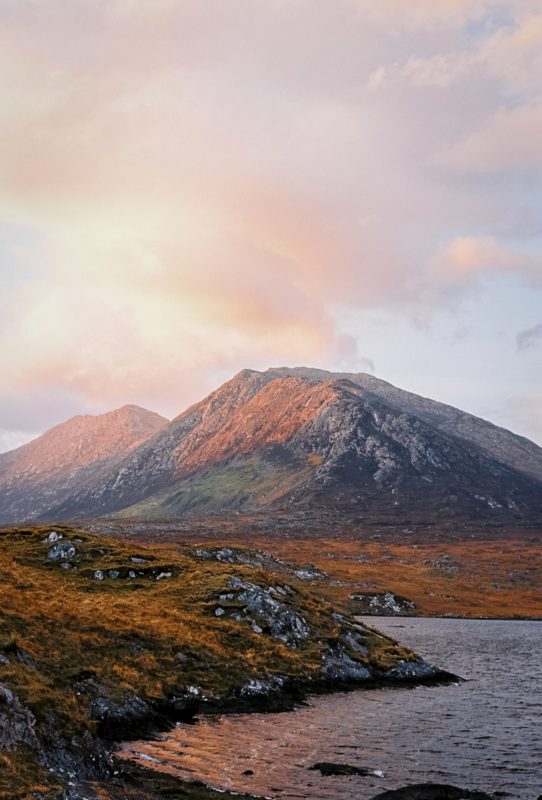
28 Great Things To Do In Connemara, Ireland
Connemara attractions include ancient ruins, movie filming sites, castles, jaw-dropping landscapes, a fjord and of course the famous Kylemore Abbey. Here are 28 things to see and do in Connemara.
Cong
We began our trip through Connemara starting in Cong which actually straddles the borders of County Galway and County Mayo, in Ireland and is the famous location for the film The Quiet Man. Nestled right on the border of Galway close to Connemara, Cong is located close to the village of Moytura, which is home to some of Ireland’s most ancient stone monuments and circles dating back to the Neolithic era. Moytura was also Oscar Wilde’s summer home as he spent his boyhood years at his father’s country residence.
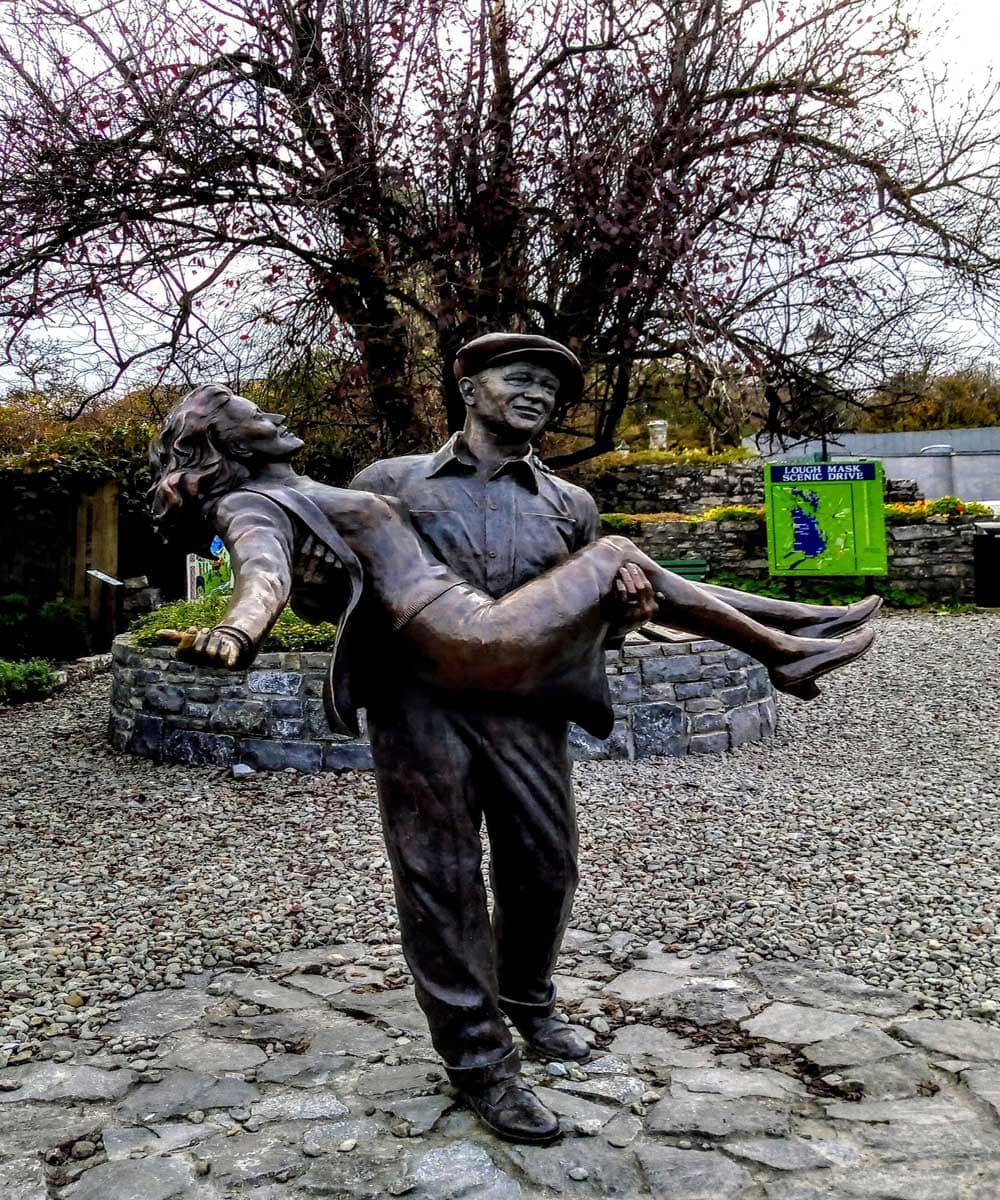
In Cong, you can explore the Quiet Man Museum, discover the ruins of the ancient Augustinian Abbey and pose beside the statue of John Wayne and Maureen O’Hara.
Aasleagh Falls
From Cong, we decided to drive up to Killary Harbour and on the way stopped at the stunning Aasleagh Falls.
Killary Harbour extends 16km (10 miles) from the Wild Atlantic Way to its head at Aasleagh, Aasleagh falls right within the Connemara Loop. Killary Harbour forms the border between Mayo and Galway and the area certainly contains some of the most spectacular scenery in the Irish West.
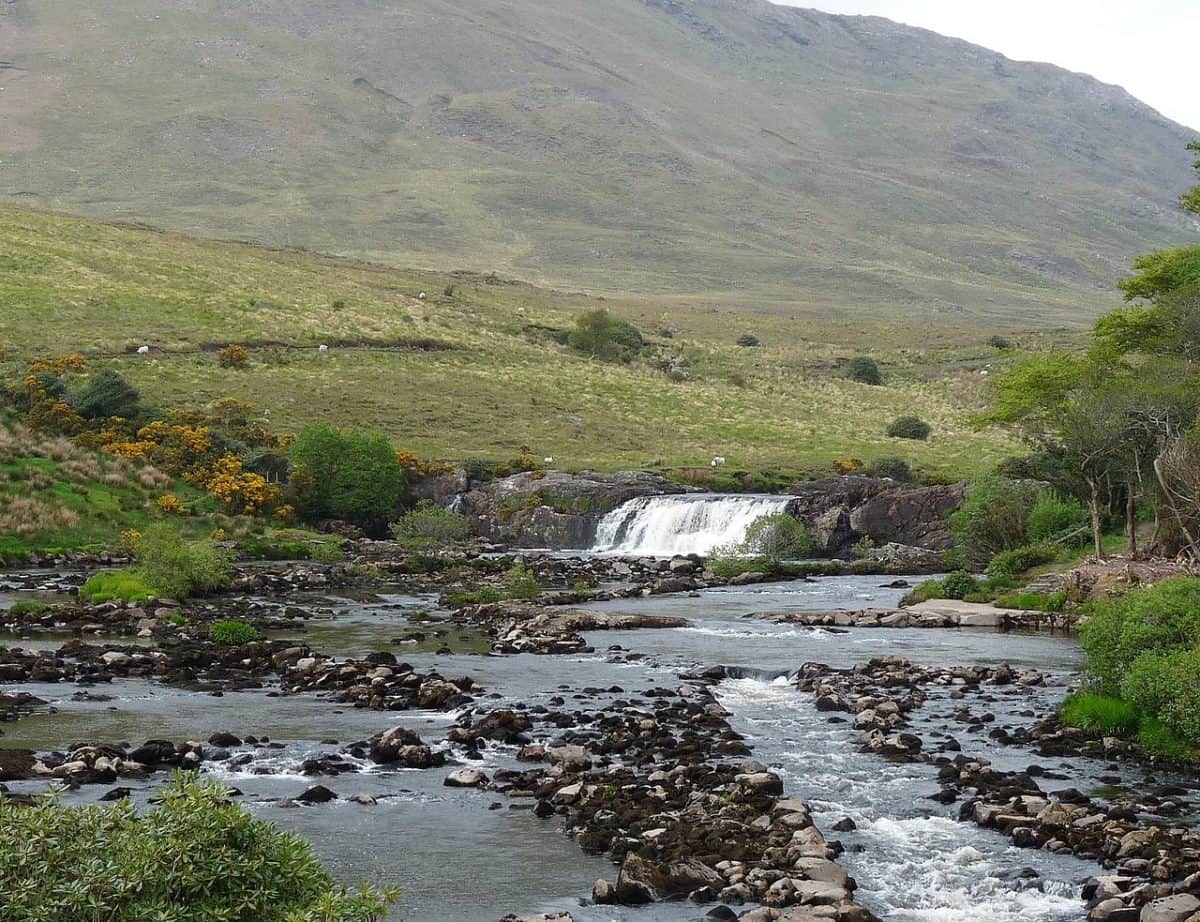
Aasleagh Falls is located a short distance from Leenane village, just north of the Galway/Mayo border. This is a picturesque waterfall, located on the River Erriff, which is famed for its salmon fishing. The waterfall is found just before the river meets Killary Harbour. Parking is available at a lay-by close to the falls on the R335 regional road. There is a pathway from the parking lot which is a short walk from the waterfall.
Killary Fjord
For centuries the Killary Fjord (An Caoláire Rua) has been known as the only fjord in Ireland. However, there is an argument ongoing between geologists that it is just one of three glacial fjords in Ireland. Killary Fjord can be found on the absolutely jaw-dropping scenic Connemara loop
To the north of the Fjord lies Mweelrea, the highest mountain in Connacht and County Mayo. To the south are the Twelve Bens and the Maumturk Mountains of Connemara. Majestic views greet visitors from all directions.
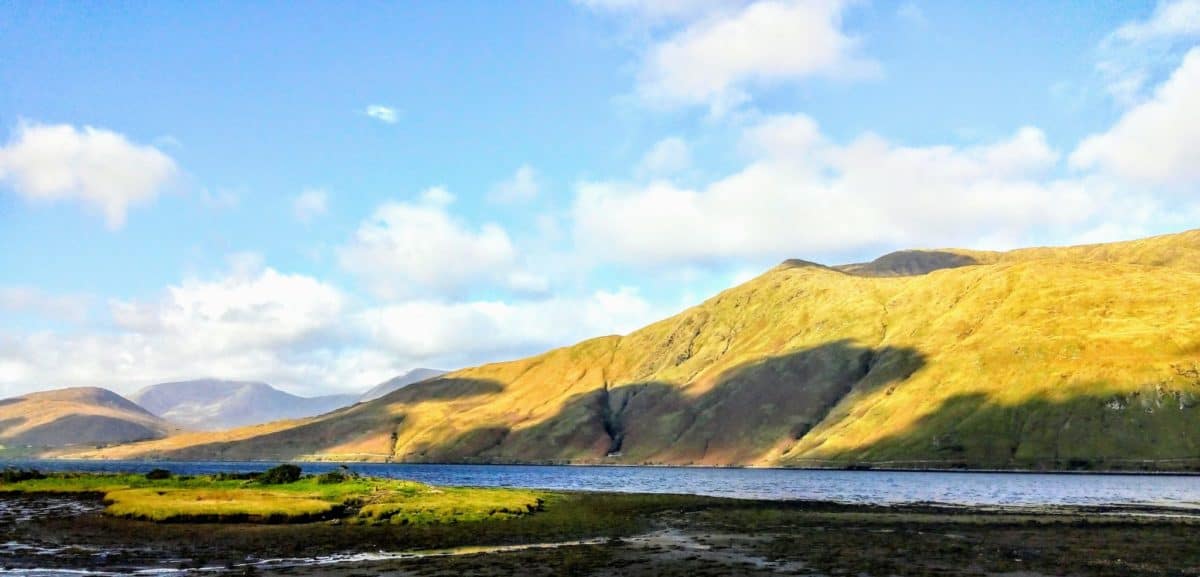
This pristine, rugged and tranquil landscape is the perfect setting for a great hike or a leisurely walk. The full loop of the fjord is about 10 miles and runs along the southern side. The walk is fairly easy and the grade is not too bad. You will pass abandoned houses, and those beautiful Irish stonewalls and you may even get to see one of those famous wild Connemara horses.
Explore Historic Connemara
Pearse’s Cottage (Ionad Cultúrtha an Phiarsaigh)
Patrick Pearse is a famous Irish revolutionary responsible for a leading role in the Easter Rising of 1916.
Pearse built a cottage in Connemara’s Gaeltacht near Ros Muc and was said to have loved the Connemara area forging strong links with the local community.

Pearse Cottage is open to the public to visit, along with a newly developed, state-of-the-art visitors centre, which offers an introduction to the Irish language, Gaeltacht culture and the local environment.
Derrigimlagh Discovery Point
The Derrigimlagh Discovery Point is famous for a couple of reasons the first being that it was the place where Marconi transmitted the first transatlantic wireless message. The second is that it was the crash landing site of the British aviator’s first non-stop transatlantic flight in history. There is a memorial in the shape of an aircraft tail on the landing site.
Aughanure Castle
Aughnanure Castle was built in the 15th century by the clan of the O’Flahertys, a family that ruled western Connaught from the 13th to 16th centuries. The castle stands on a rocky island in the Drimneen, on the shores of Lake Corrib, where another castle once stood on this site, erected in 1256, and built by the Normans.

The castle is actually a 6-storey tower, the only access to which is a rocky bridge, which leads to the entrance of the fort. It had formerly been fortified by a double enclosure as well as by battlements serving as a rampart and defence for the clan of the O’Flahertys.
Kylemore Abbey
Most visitors to Ireland have on their travel bucket lists a visit to Kylemore Abbey. Kylemore Abbey is tucked into the base of a small mountain on the edge of a glistening lake in Connemara. The tale of the Abbey at Kylemore begins with a tragic love story.
Kylemore was built by a British politician Mitchell Henry 1868 as a gift for his wife Margaret but tragically Margaret died in 1875 after travelling to Egypt and contracting a fever. Henry was devasted and built a shrine to Margaret in a memorial chapel which you can visit.
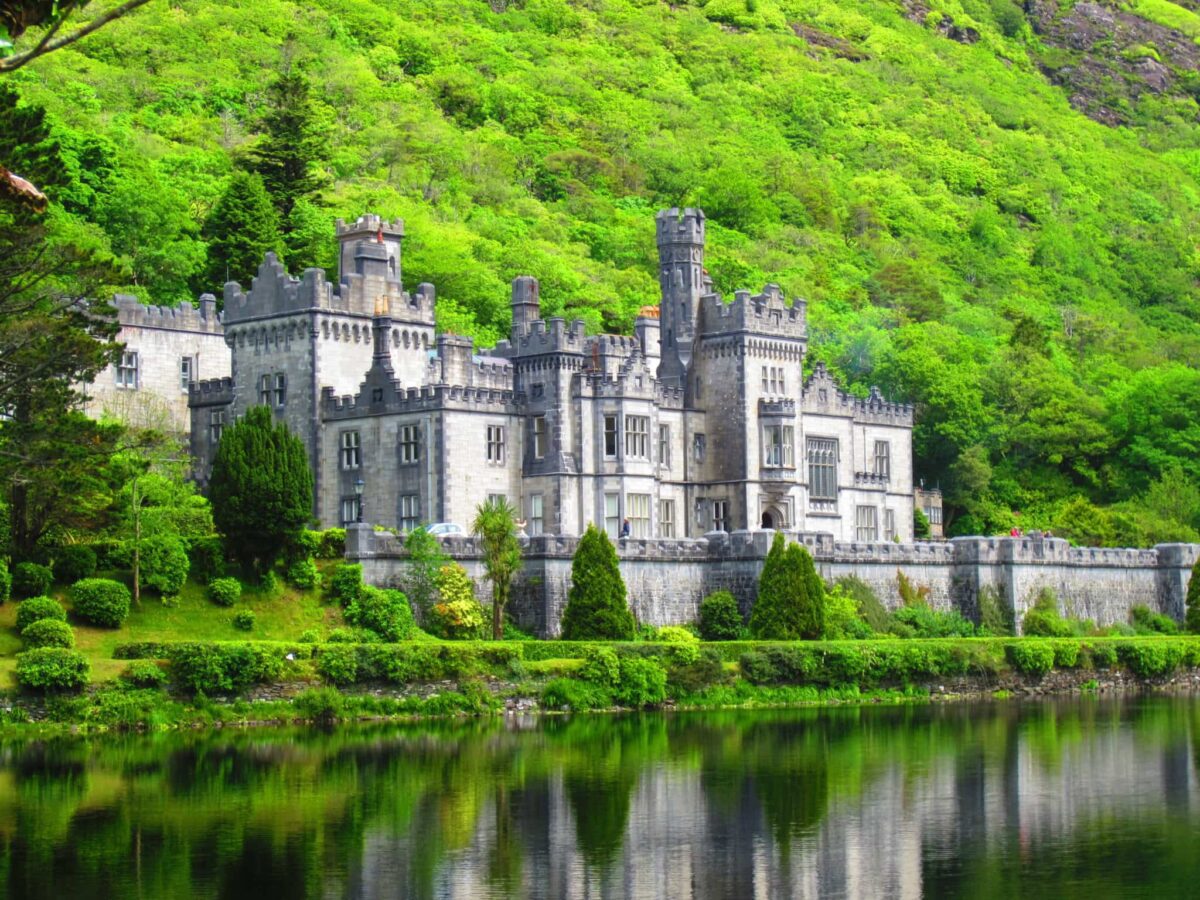
The real highlight of visiting Kylemore Abbey is strolling the 6-acre Victorian Walled Garden. The buildings are beautifully restored and there are woodland walks, gurgling streams, nature trails and play trails for the children. Your ticket to Kylemore includes a shuttle bus that is caught behind the Visitors Centre and it takes you down to the gardens.
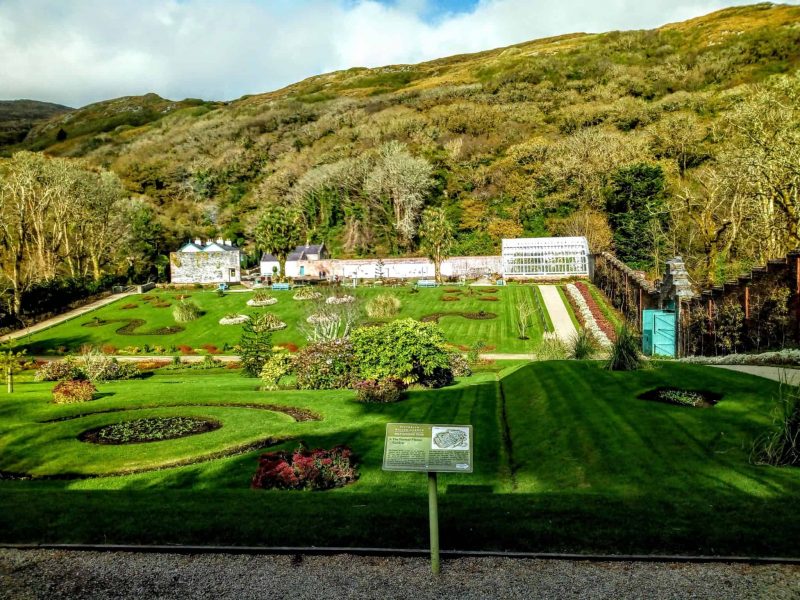
In the Abbey itself, you are only allowed onto the main floor and there are two furnished rooms you can see. Not all that impressive when compared with the rest of this incredible estate.
Clifden Castle
Clifden Castle is situated 2km from Clifden. This ruin overlooks the sea and can be reached by the farm track near the Sky Road. Once a Gothic mansion, the d’Arcys lived here until 1850 when the estate was sold to the Eyre family who lived here until the castle fell into ruin in when it was abandoned in 1935.

Explore the Glengowla Mines & Family Farm Experience
At Glengowla Mines and Family Farm Experience, you will find lots to do- an Underground Mine Tour, Sheep Herding, Irish Turf Cutting Demonstrations and farm walks.
This Connemara mine used to mine lead and silver but was abandoned in 1865 and these days you can get a glimpse of it by visiting some of the tunnels and a small museum, where miners were trying to mine silver and lead.
Things to do in Connemara
Letterfrack
Letterfrack is the gateway to the Connemara National Park and is known throughout Ireland for its live music scene. The town itself is set in some incredibly picturesque Irish landscape sitting at the mouth of Ballynakill Bay and the foot of Diamond Hill.
Letterfrack hosts two well-known Irish music festivals Bog Week and Sea Week which bring in traditional musicians and audiences that love a trad session and a good hike.
Letterfrack is a popular base for exploring the area and there are loads of things to do in Connemara using this town as your base.
Connemara National Park
Spanning over 2000 hectares Connemara National Park (one of six national parks in Ireland) is located in the northern part of the region between Clifden and Letterfrack.
You can’t drive through the National Park, but there are several National Park Walks you can hike. The easiest is the Ellis Wood Trail which is about half a kilometre. Or you could climb Diamond Hill.

The park contains many blanket bogs, forests, smoky purple heaths, mountains and grasslands that were shaped by the last Ice Age. The state-owned park was owned originally by the Kylemore Estate.
You probably know about the Connemara Ponies which live in the park and are descended from a herd of pure-bred animals that were given to the State by the late President Childers in 1974.
Within the Park, you will spot 4,000-year-old megalithic tombs and many signs of the previous inhabitants in ruined cottages and sheep lots of sheep.

Entry into the national park is free of charge and at the visitor’s centre in Letterfrack, You can find the trail maps for your hike. There is also a Tea Room where you can enjoy a good cup of Irish tea after your hike.
Diamond Hill
Diamond Hill is one of the most famous hikes in Connemara and the short trail will take around an hour to an hour and a half to complete hours to complete. The Upper Trail takes around 2 to 2 and a half hours and both routes start from the Visitor Centre and will provide you with some outstanding views.
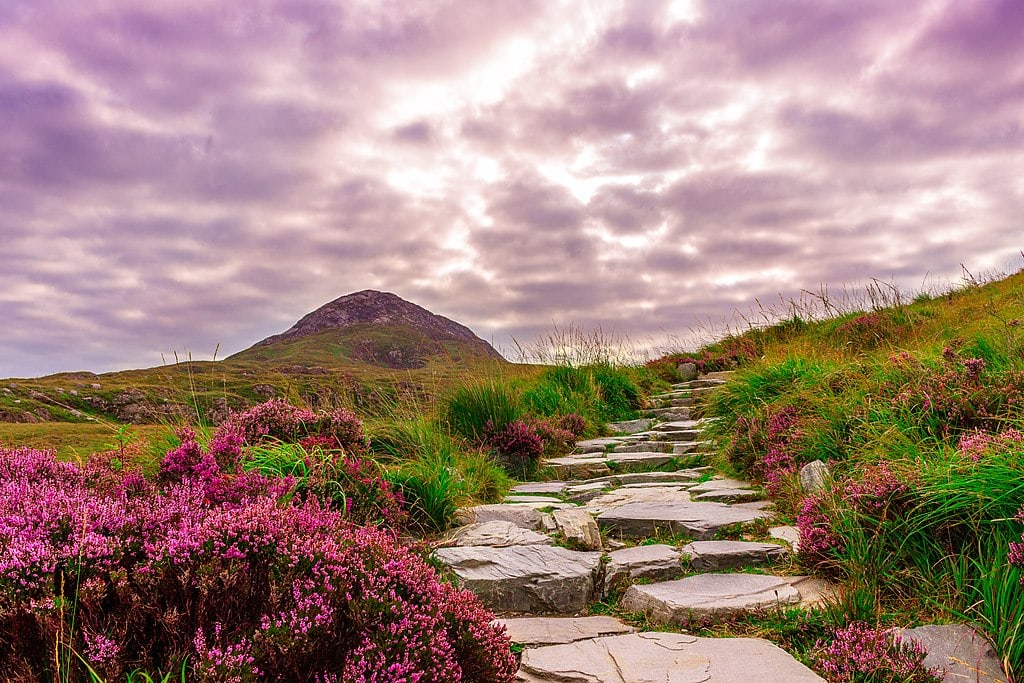
Drive the Bog Road
Blanket bogs dominate the landscape of much of Connemara from the Twelve Bens to the Maumturk mountains. Particularly beautiful in fall when the purple moor grass turns to gold and the heather is in bloom this is an incredible part of Ireland’s landscape.
Scientists consider Ireland’s bogs as a type of rainforest as they absorb water and release it throughout the year feeding the rivers and streams for trout and salmon and containing rare wild and insect life.

The road only takes around 15 minutes to drive but take time and stop to explore the area and scenery you won’t regret it.
Drive the Sky Road Loop
The Sky Road is a road of about twenty kilometres in Connemara. It starts at the western exit of Clifden which is considered to be one of the most beautiful roads in the region.
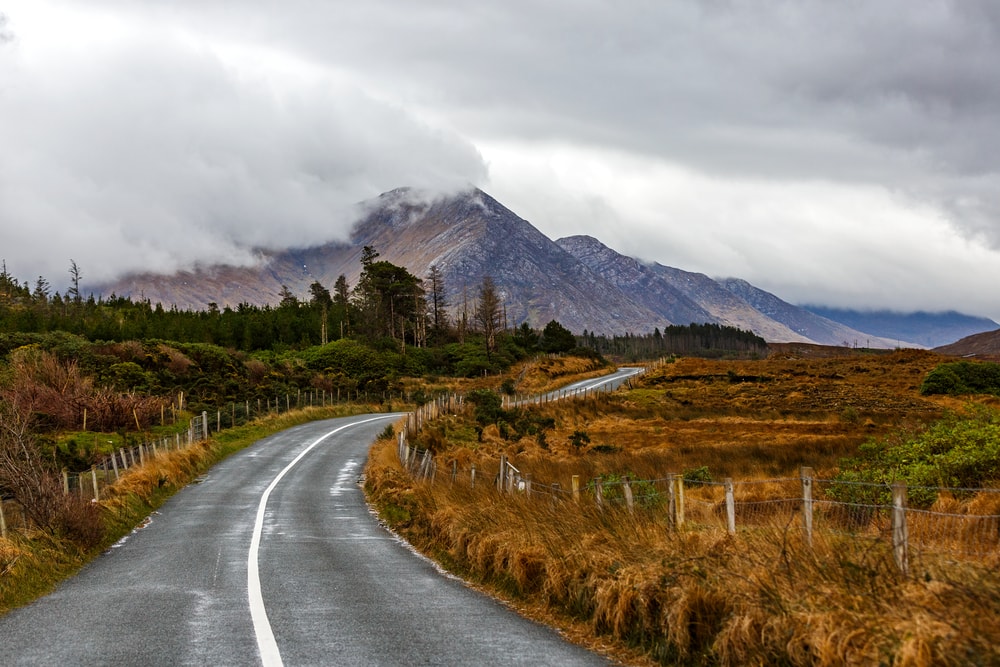
The Sky Road does not often appear in the list of must-do’s of Ireland like the Cliffs of Moher, the Giant’s Causeway or Slieve League, but it shouldn’t be missed.
If you start your visit from Clifden you can see its magnificent bay and the road then climb through the mountains giving you breathtaking views of the ocean and the islands of the area.

Be careful in driving some of the roads are very narrow and you will have to pull over to let other vehicles pass. Watch for sheep they are everywhere on the Sky Road.
Explore Clifden
Clifden is the largest town and is considered the capital of the Connemara region. It isn’t an old town, as it was founded at the start of the 19th Century by John D’Arcy, the local landlord, who lived in Clifden Castle, now a roofless ruin on the scenic Sky Road running westwards along Clifden Bay.
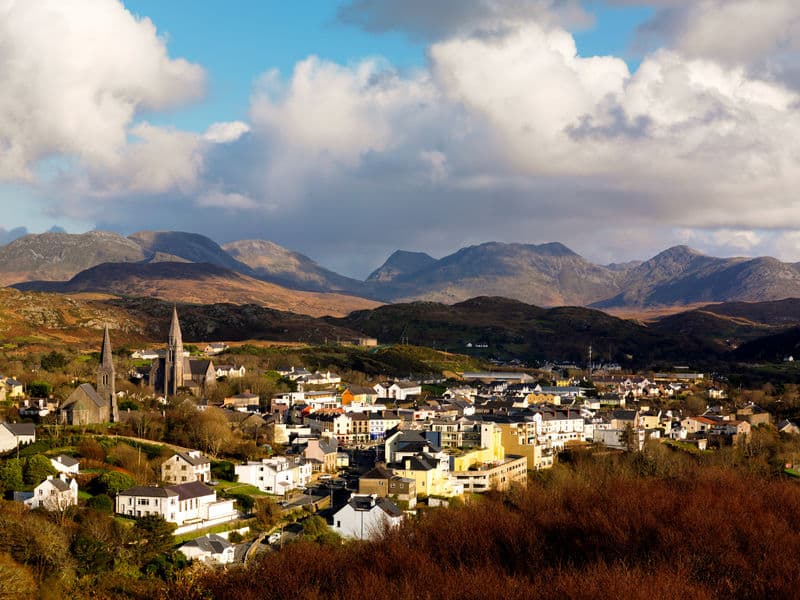
The scenery around Clifden is extraordinary. Clifden’s skyline is dominated by the spires of the Neo-Gothic Catholic Church and nearby Protestant church. The Twelve Bens provide a wonderful backdrop to the town and some incredible seafood is harvested from Clifden Bay which can be enjoyed in many of the fine restaurants and cafes in town.
You might also like to read about the most beautiful towns and villages in Ireland
Beaches in Connemara
Connemara is famous for its stunning beaches and is one of the best things to do in Connemara.
Dogs Bay Connemara
Dogs Bay is a bay located near Roundstone and Errisbeg Mountain and nearby you can find the very pretty Gurteen Bay cove.
This double bay offers fabulous beaches and beautiful views. The beach is considered one of Ireland’s best surfing beaches and perfect for water sports.
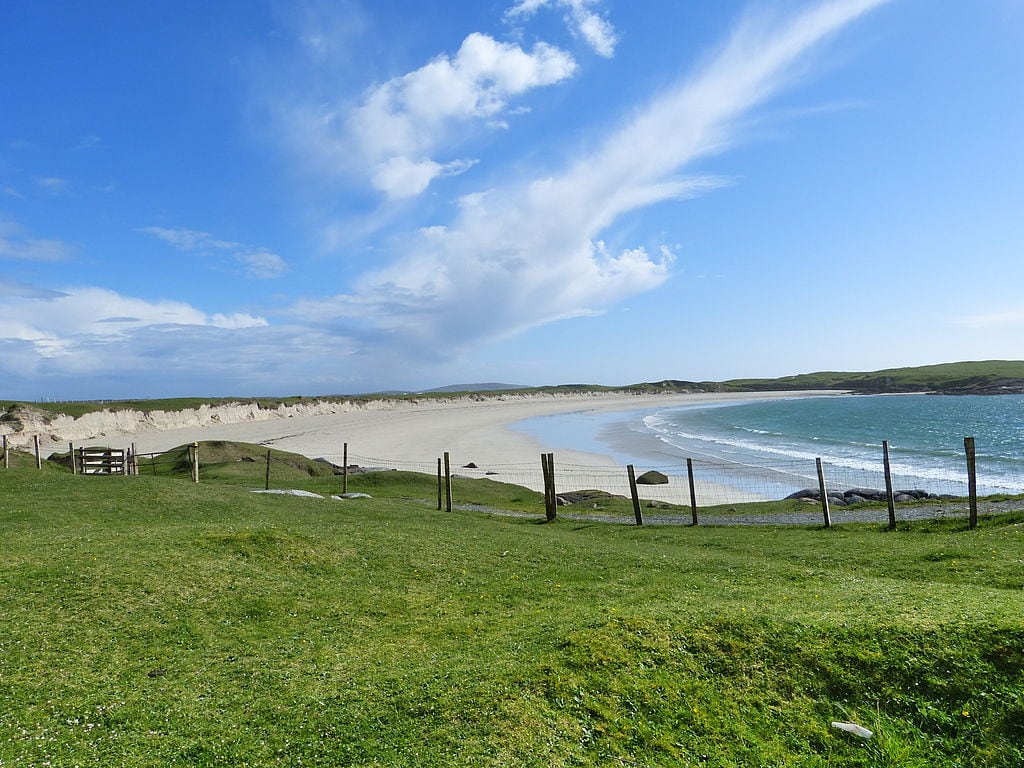
Gurteen Bay
Gurteen Bay is a lovely quiet beach with soft white sand and some of Ireland’s clearest waters and a cool place to snorkel.
Renvyle Beach
Renvyle beach is a huge beach locally known as White Strand Beach due to its great white sandy beach. Views of the incredible Mweelrea mountains can be seen from the beach.

Glassilaun Beach
Located between Killary Harbour and Renvyle you will find Glassilaun the most popular beach in Connemara. It is surrounded by wild rugged scenery with a backdrop of mountains.
Mannin Bay
A brilliant beach for rockpooling and a 4.5 km rocky coastline where you can experience the powerful Atlantic Ocean.
Coral Strand
An unusual beach for Ireland Coral Strand’s beach is made up of calcified seaweed and feels like fine gravel when walking the beach. Another area that is perfect for rock pooling along the rugged shore it is also great for a swim on a good day.
The Islands of Connemara
Inis Mór
Inis Mór is the largest of the three Aran Islands and a trip to the island makes a popular day trip from Connemara. The ferries leave from Rossaveal (leaving Galway city) all year and from Doolin (Cliffs of Moher) from April to October.
There are pony trap and bus tours of the Island and over 50 different monuments of Christian, pre-Christian and Celtic mythological heritage to find. The merchants and café on the island don’t take credit cards or debit so make sure you take some cash.

Don’t forget to visit Dún Aonghasa located on the 300-foot cliff side of the island. This semi-circular stone fort has some incredibly dramatic views of the Atlantic and the island. Considered one of the best examples of a stone fort in Europe Dun Aonghasa is hoping to obtain UNESCO World Heritage Status.

Inis Meáin
Inis Meain Island has a population of 200 people, it is the less visited of the three islands. Visiting Inis Meain is the perfect place to see some fascinating Celtic and Christian sites. It is also a brilliant centre for diving if you are so inclined because the waters are so clear.
Inis Oírr
Inis Oirr (Inisheer) is the smallest of the Aran islands and sits close to the Burren and the Cliffs of Moher. The pristine white sandy beach faces stunning turquoise waters with many fishing boats bobbing in the Atlantic waters.

The main village is right next to the beach and sits by a small hill with a ruined castle and fort at the top. Take a walk to the lighthouse or tour the island by bike.
Inishbofin Island
Inishbofin (land of the White Cow) lies seven miles off Galway’s coast. The Island has three looped walks from easy to painful and each offers some spectacular views of the land and seascapes.
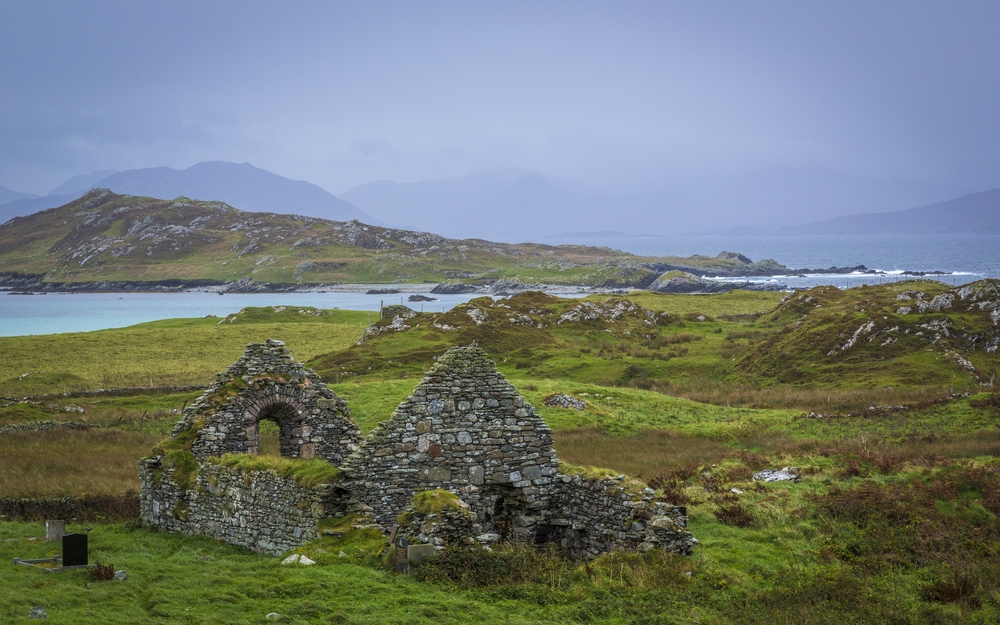
The Island has several award-winning sandy beaches for swimming and snorkelling and there is some fantastic diving offshore. Inishbofin is a special area of conservation and a special area of protection. The island is a breeding area for many species of birds.
You might also like to read about Ireland’s Islands
Pony Trekking
For those who would like to experience Connemara and take part in some pony trekking or ride a horse on the beach, there are a wide range of options available from Connemara’s riding centres.
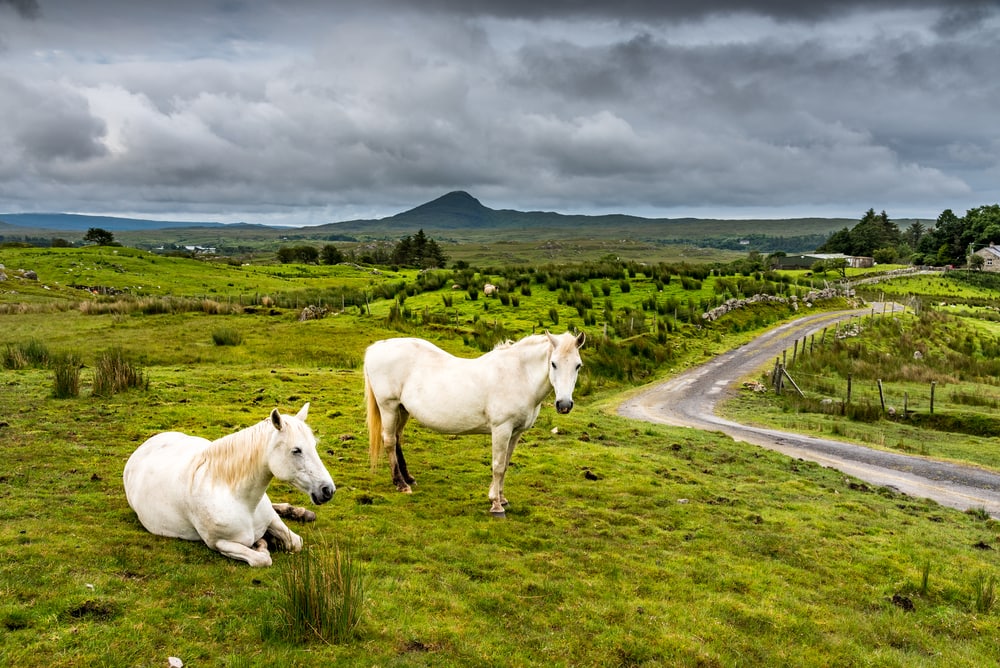
With an unspoiled landscape and beautiful scenic views, there are several excellent riding and equestrian centres in Connemara that cater to private or group lessons.
Connemara for foodies
From farm to fork, sea to plate Connemara is a true foodie paradise. Irish food has come miles in the past 20 years and one of the best things to do in Connemara is eating.
Thanks to its beside-the-sea location this is of course a huge part of the local culinary scene. From the Killary Harbour mussels to Cleggan crab, and Dooncastle oysters Connemara is a glorious foodie paradise.
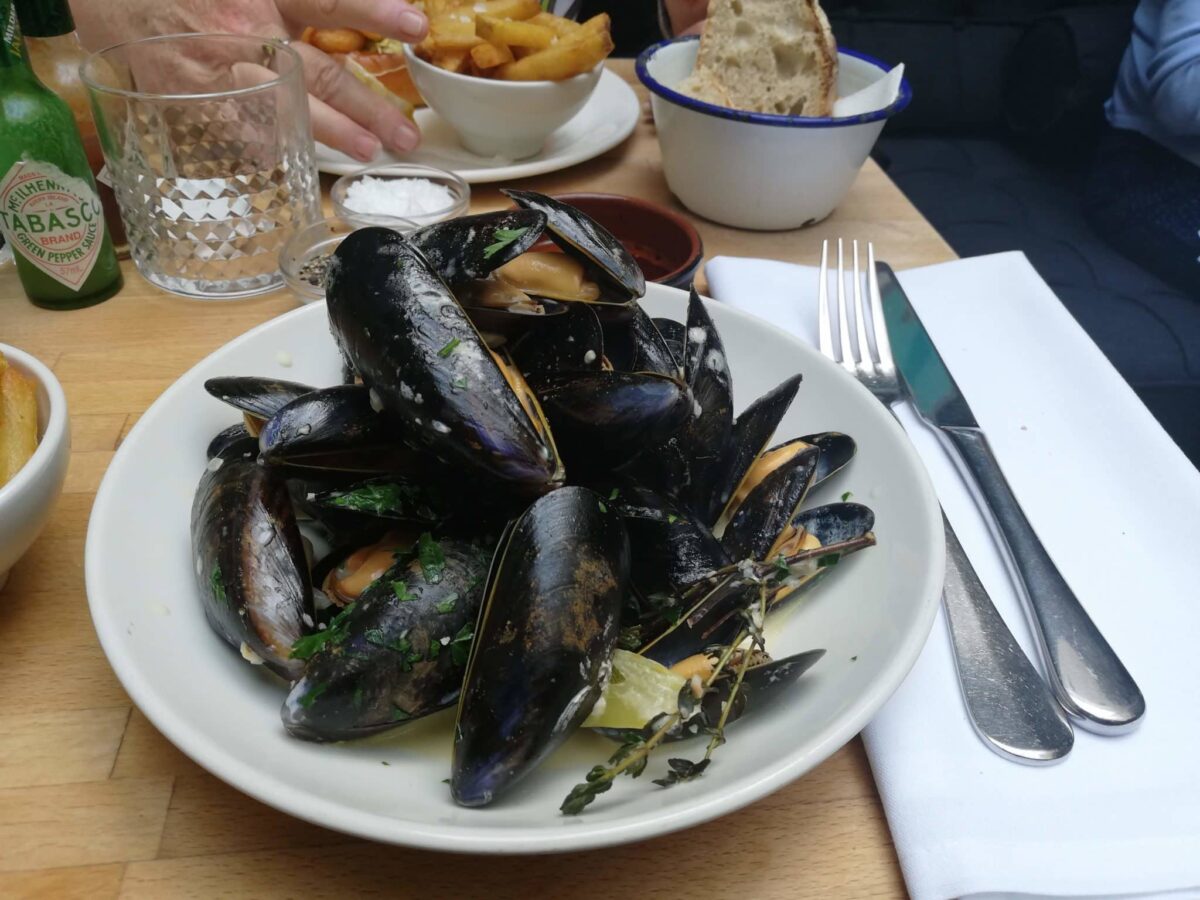
There’s local trout and salmon, wild foraged greens and seaweed, lamb and mutton, and beef and wild game all locally reared or caught.
If you are up near Killary Fjord go and eat from the best food truck in Ireland. The Misunderstood Heron sits right on the edge of the fjord and serves up creative dishes that need to be tasted and a fabulous cup of coffee.
Opened in 1979, Ballyconnelly Salmon Smokehouse is a family business that devotes its time to smoking fish. Considered the oldest smokehouse in all of Connemara, it prepares salmon (farmed or wild), as well as mackerel or tuna.
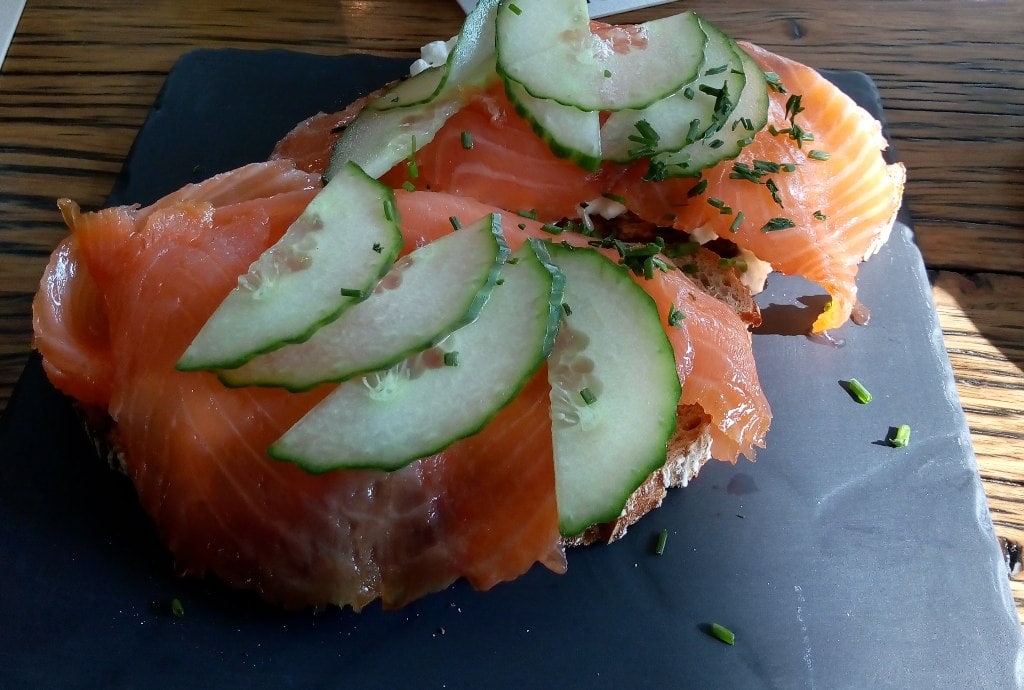
Where to Stay in Connemara
The Connemara Hostel (Sleepzone)
The Connemara Hostel offers both private and dormitory accommodation (all en suite), the hostel provides free internet and WiFi access, bureau de change, tourist information, a self-catering kitchen, a residents’ lounge, TV & games room, pool table, private tennis courts, parking and camping facilities.
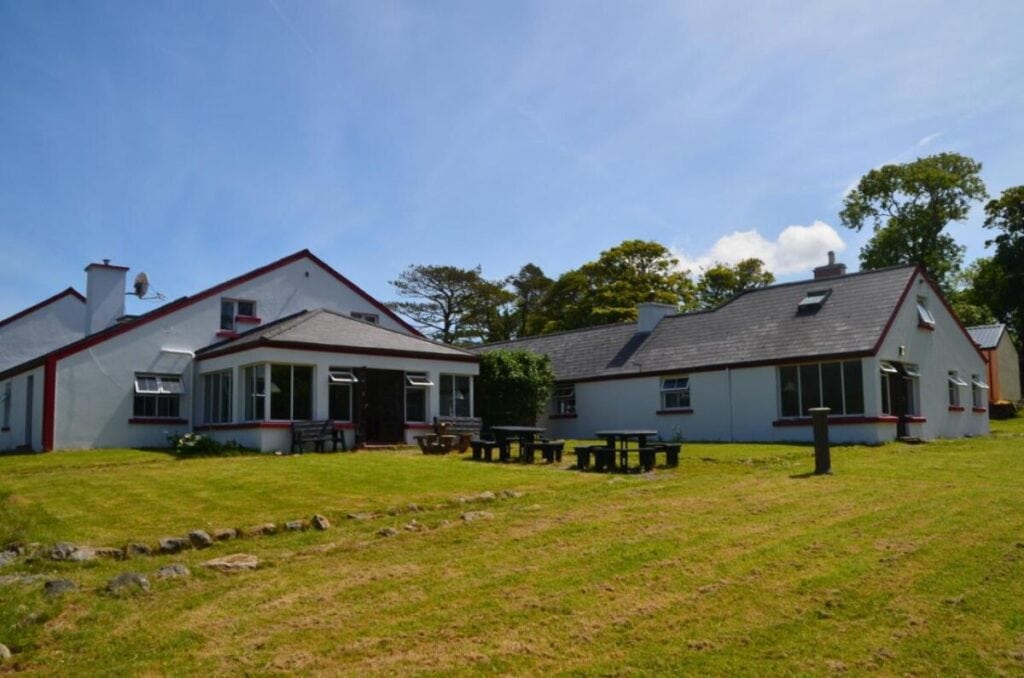
The Connemara Hostel makes the perfect base for fantastic mountain walks, cycling, and horse riding; visiting Kylemore Abbey and Connemara National Park.
The Leenane Hotel
The Hotel is located in the village of Leenane in Co Galway, Ireland – part of the Connemara region of Ireland. Overlooking Killary Harbour, the Hotel enjoys what is perhaps one of the most scenic locations in Ireland.

Originally established as a Coaching Inn, the earliest records show that there has been an establishment in existence here since the 1790s. As you would expect, standards have come a long way since then but you will still find that the essential character of the Hotel and the surrounding area remains.
Killary Adventure Centre B&B hostel
Killary Adventure Co has everything you need for a fantastic activity holiday in Ireland including over 20 of the most exciting adventure activities to choose from and a stunning location.
Kayak on Ireland’s only Fjord, take on the famous Turf Challenge or if you have a head for heights try out the High Ropes Course, Climbing Walls or Burma Bridge & Skyfall! Activities are available to those aged 8+ whether you are a solo adventurer, a group of friends, a family or looking for something to entertain the kids this summer!
If you need accommodation the Killary Adventure Centre overlooks Killary Fjord on the Wild Atlantic Way and offers hostel-style accommodation with 4/6 bed dorm rooms and Twin/Doubles. This is the perfect location for exploring all that Connemara offers the outdoor enthusiast.
BOOK THE KILLARY ADVENTURE CENTRE
You will find plenty of options at Booking.com from B&B is to hostels and lodges in the area to stay at.
Ballynahinch Castle Hotel
Originally a pretty damned special fishing lodge, Ballynahinch Castle occupies over 700 acres in the heart of Connemara. Dating from the 1700s with a stunning backdrop of the 12 Bens Mountains It has been rated as one of the finest hotels in Ireland.
Inhabited at one time by Ireland’s Pirate Queen Grace O’Malley celebrities such as Margaret Atwood have stayed here. What makes it special?
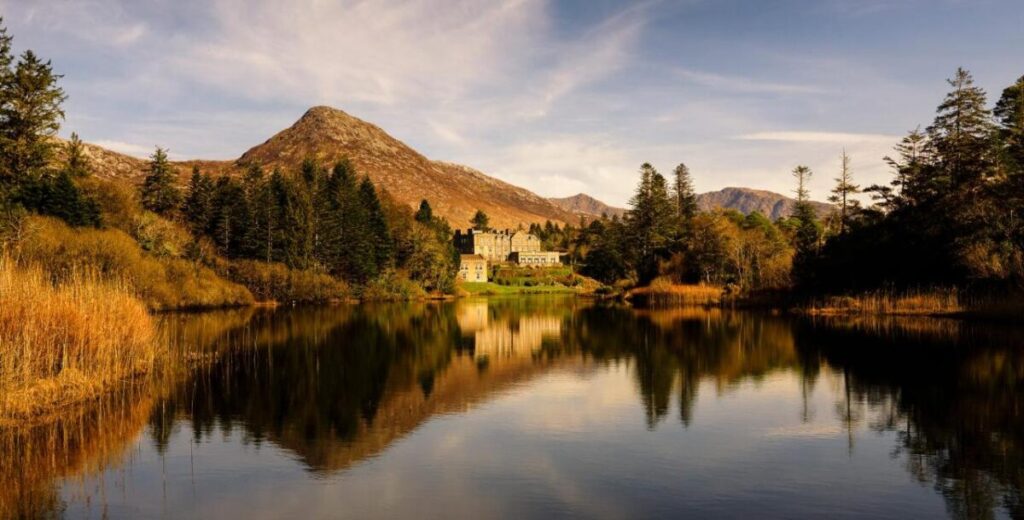
Occupying 700 acres in the heart of Connemara on a backdrop of the 12 Bens Mountain Range, Ballynahinch Castle is renowned as one of the finest fisheries in Ireland. Dating from the 1700s, Ballynahinch celebrates its origins as a fishing lodge with wood panelling, traditional parlours, riverside rooms and quiet forest trails.
One of the finest hotels on the Wild Atlantic Way the amenities include breakfast, afternoon tea, fine dining, a pub and lots of outdoor activities. Learn to clay shot, or simply pull on your hiking boots and head off for a hike or bicycle in the glorious countryside.
BOOK THE BALLYNAHINCH CASTLE HOTEL NOW
There are so many things to do in Connemara you could spend your whole vacation here. If you really want to see one of the wildest areas of Ireland outside Donegal of course you should put Connemara on your list.
You might also like
53 Ultimate Ireland travel tips
Planning a dream trip to Ireland? Everything you need to know
Castle Hotels in Ireland – 33 Fabulous Castle Hotels to stay in
Pin it to save it
